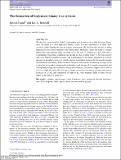Files in this item
The formation of high-mass binary star systems
Item metadata
| dc.contributor.author | Lund, Kristin | |
| dc.contributor.author | Bonnell, Ian A | |
| dc.date.accessioned | 2018-09-04T12:30:05Z | |
| dc.date.available | 2018-09-04T12:30:05Z | |
| dc.date.issued | 2018-09-11 | |
| dc.identifier | 255714761 | |
| dc.identifier | a460f98b-e972-4d56-8672-35d594010c84 | |
| dc.identifier | 85054815732 | |
| dc.identifier | 000441380100054 | |
| dc.identifier.citation | Lund , K & Bonnell , I A 2018 , ' The formation of high-mass binary star systems ' , Monthly Notices of the Royal Astronomical Society , vol. 479 , no. 2 , pp. 2235-2242 . https://doi.org/10.1093/mnras/sty1584 | en |
| dc.identifier.issn | 0035-8711 | |
| dc.identifier.other | RIS: urn:F95C8A5FD0EC351C982B767265CCA8D9 | |
| dc.identifier.uri | https://hdl.handle.net/10023/15961 | |
| dc.description | KL acknowledges financial support from the Carnegie Trust. IAB acknowledges support from the ECOGAL project, grant agreement 291227, funded by the European Research Council under ERC-2011-ADG. | en |
| dc.description.abstract | We develop a semi-analytic model to investigate how accretion on to wide low-mass binary stars can result in a close high-mass binary system. The key ingredient is to allow mass accretion while limiting the gain in angular momentum. We envision this process as being regulated by an external magnetic field during infall. Molecular clouds are made to collapse spherically with material either accreting on to the stars or settling in a disc. Our aim is to determine what initial conditions are needed for the resulting binary to be both massive and close. Whether material accretes, and what happens to the binary separation as a result, depends on the relative size of its specific angular momentum, compared to the specific angular momentum of the binary. When we add a magnetic field we are introducing a torque to the system that is capable of stripping the molecular cloud of some of its angular momentum, and consequently easing the formation of high-mass binaries. Our results suggest that clouds in excess of 1000 M⊙ and radii of 0.5 pc or larger, can easily form binary systems with masses in excess of 25 M⊙ and separations of order 10 R⊙ with magnetic fields of order 100 μG (mass-to-flux ratios of order five). | |
| dc.format.extent | 8 | |
| dc.format.extent | 1078437 | |
| dc.language.iso | eng | |
| dc.relation.ispartof | Monthly Notices of the Royal Astronomical Society | en |
| dc.subject | Binaries: spectroscopic | en |
| dc.subject | Stars: formation | en |
| dc.subject | Stars: luminosity function, mass function | en |
| dc.subject | ISM: magnetic fields | en |
| dc.subject | Open clusters and associations : general | en |
| dc.subject | QB Astronomy | en |
| dc.subject | QC Physics | en |
| dc.subject | NDAS | en |
| dc.subject.lcc | QB | en |
| dc.subject.lcc | QC | en |
| dc.title | The formation of high-mass binary star systems | en |
| dc.type | Journal article | en |
| dc.contributor.sponsor | European Research Council | en |
| dc.contributor.institution | University of St Andrews. School of Physics and Astronomy | en |
| dc.identifier.doi | 10.1093/mnras/sty1584 | |
| dc.description.status | Peer reviewed | en |
| dc.identifier.grantnumber | en |
This item appears in the following Collection(s)
Items in the St Andrews Research Repository are protected by copyright, with all rights reserved, unless otherwise indicated.

